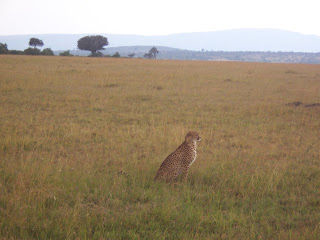There were some women from the Masai lined up at the gate, showing off various souveneirs, which they offered at vastly inflated prices. I think all of us were pretty much set for souveneirs at this time, so we tried to ignore them until the armed guard opened the gate and allowed us in. For the following two days, when we entered and left as the park opened/closed, we did not see these women. I guess they make enough that they don't have to get up early or stay til the end of the day.
A selection of skulls, just inside the entrance.
Our ride was a van, and the roof lifted up to allow us to stand and get a view of whatever animal was in the area.
I have to admit I was uncertain about how many animals we would see. It was at the beginning of the migration time, so I thought that maybe we would spend a lot of time chasing down something to see. But we found some animals just a few short metres from the gate; wildebeest and Thomson's gazelles grazing together.
I have to admit I was uncertain about how many animals we would see. It was at the beginning of the migration time, so I thought that maybe we would spend a lot of time chasing down something to see. But we found some animals just a few short metres from the gate; wildebeest and Thomson's gazelles grazing together.
They were a little skittish, and kept an eye on us as we slowly passed by. Later on, as we were leaving, we saw some of the male wildebeest chasing off some hyenas. It was dusk, and they were a ways off, so we couldn't get a good picture. We saw some hyenas the next day, as well, which is when I took their picture.
We also saw some jackals:
and we would just catch a glimpse of warthogs before they disappeared into the tall grass. I don't think any of us got a good picture of them.
Anyway, the next animal we saw was a lone giraffe, ambling across the plain. Looking for Rusty, I think.
Heh.
Heh.
Seeing these animals in the wild is hard to describe. At the time, you can hardly believe what you are seeing. Someone once said that if you have to beg, borrow, or steal in order to go on a safari, it's definitely worth it. The truth of that statement was becoming clearer and clearer as this first day went on.
We came across some more grazing animals as we went further, including zebras:
and impalas:
But then we saw, off in the distance.... elephants.
Ooooooh.
We raced over to them just as they reached a pool of water about the size of a dining room table. They stopped to throw some mud and water over themselves. They were very protective of their young, and especially of a very young elephant, and we were just in awe of them as they went about their business and then ambled off.
This was about an hour and a half into our very first foray into the park, and I thought at the time that this would be as good as it got. The variety of animals we had seen so far, culminating in the small herd of elephants, had made the expense of the trip more than worth it, in my eyes.
But it just kept getting better.
We were heading further in to the park. The sky was kind of cloudy, threatening rain, and there was a haze that obscured the hills on the horizon. We had just seen a secretary bird:
when we saw the first predator, gazing at the grazing animals in the distance, a cheetah:
And then, futher on down the road, a couple of lionesses on the prowl.
They were nice enough to pose for us:
and even smile... nicely... for the camera:
And then it was time to head back to the camp. There was some rain coming down as drove out of the park, but it didn't last too long. As I reflected on the variety of animals we had seen, I was thankful that the trip had gone so well. We were going to have a couple more trips over the next two days, and I looked forward to what they would bring.
































